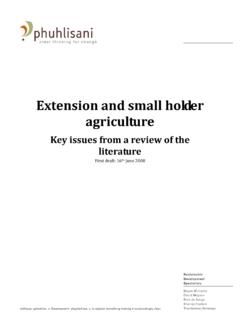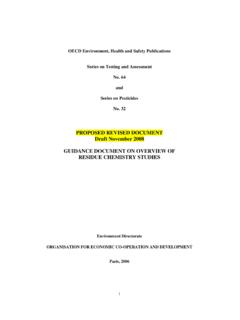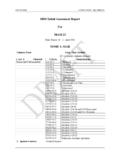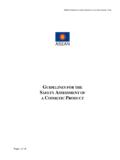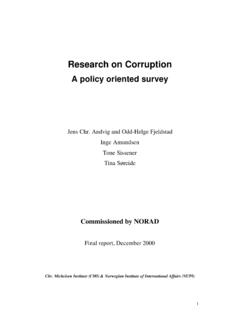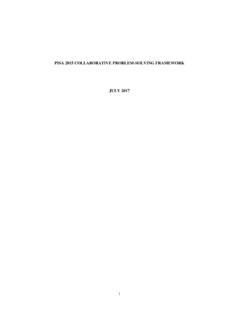Transcription of Paper - Evaluating the impact of capacity building …
1 Evaluating the impact of capacity building activities in the field of Food Quality and Safety Design of an evaluation scorecard and indicators Note: This report was prepared by Hilbert van der Werf, a volunteer working at FAO in 2007. This report does not necessarily reflect the position of FAO, but is provided for information. This is not an official FAO publication and has not been formally proofread. Evaluating the impact of capacity building activities in the field of Food Quality and Safety Design of an evaluation scorecard and indicators DRAFT Paper Hilbert van der Werf, Volunteer AGNS Supervision: Dr. Maya Pi eiro, Senior Officer AGNS Rome, July 2007 i Acknowledgements This Paper was prepared by Hilbert van der Werf, Volunteer and Maya Pi eiro, Senior Officer, Food Quality and Standards Service in the Nutrition and Consumer Protection Division.
2 The inputs of all attendees from the meeting1, as well as the individual inputs from Catherine Bessy, Renata Clarke, Julius Jackson, Mary Kenny and Masami Takeuchi (AGNS) and Roberto Cuevas Garcia (AGST) are greatly appreciated. A special thanks is addressed to Marlynne Hopper (AGNS), for giving very valuable comments on an early draft of this document. 1 For an overview of attendees, see Appendix 12 ii Scope and objectives The demand for planning and evaluation in development activities through logical frameworks and indicators is increasing. The goal of the study, of which the results are presented in this Paper , was to develop a set of indicators for measuring the impact of capacity building activities in the field of food safety and quality. Indicators can serve as a very useful tool, both for Evaluating and discussing the outcomes of capacity building activities , as for setting targets and reaching consensus among stakeholders on objectives.
3 Following the terms of reference which are presented in Appendix 13, a literature research and expert meeting were conducted to reach the described goal. Contents and structure The presented indicators are based on literature research, benchmarking and insights from FAO staff members. The Paper starts with an introduction to the background of capacity building activities from AGNS (Chapter 1) and a benchmark on monitoring and evaluation of activities from other development agencies and literature (Chapter 12). From this benchmark, a view lessons are learned which are presented as recommendations for the development of indicators. Also, the Framework of activities and results (Appendix 2) and the Evaluation Scorecard (Appendix 3) were based on lessons learned from literature. The actual set of generic indicators, that was refined based on the internal meeting, is presented in Chapter 4 (an overview can be found in Table 3 (page 12).)
4 Also in Chapter 4, recommendations are given on how to further refine the indicators when applying them to specific projects. iii Table of Contents Acknowledgements ..i Scope and objectives ..ii Contents and structure ..ii Abbreviations ..v 1 Project 1 1 Methodology .. 2 2 Monitoring and Evaluation .. 3 Benchmarking .. 3 Choices in monitoring and 4 Developing indicators .. 6 Conclusions .. 8 3 Developing 9 Collection of 9 Gathering factors .. 9 Defining issues .. 9 4 Recommendations for generic outcome 11 Introduction .. 11 Food Control Management .. 15 Food 21 Food Inspection .. 22 Official Food Control Laboratories .. 26 Food Safety and Quality Information, Education and Communication (IEC) .. 28 5 Appendixes .. 30 6 References .. 46 iv List of Appendixes Appendix 1 Three types of indicators for HIV/AIDS prevention .. 30 Appendix 2 Framework of activities and 31 Appendix 3 Evaluation Scorecard.
5 32 Appendix 4 Institutionalizing capacity Development Focus in Country Programming and 33 Appendix 5 End evaluation of training 34 Appendix 6 National Sanitary Veterinary and Food Safety Authority (Romania)..36 Appendix 7 Quality Cost Report: Tabular Format .. 37 Appendix 8 Sample Primary Production Facility Inspection Check 38 Appendix 9 List of laboratory materials .. 41 Appendix 10 Standard format for exchange of information between countries on rejections of imported food .. 42 Appendix 11 The Aid Effectiveness Pyramid .. 43 Appendix 12 Attendees expert meeting .. 44 Appendix 13 Terms of Reference .. 45 v Abbreviations ADB Asian Development Bank AGNS Food Quality and Standards Service AS Assurance System BSc Bachelor of Science CBI Coffee Board of India CIDA Canadian International Development Agency DANIDA Danish International Development Agency DEFRA Department of the Environment, Food and Rural Affairs (UK)
6 EC European Commission ECDPM European Centre for Development Policy Management FAO Food and Agricultural Organization of the United Nations FS Food Safety FSQ Food Safety and Quality FSA Food Safety Authority GAP Good Agricultural Practices GDP Gross Domestic Product GEF Global Environment Facility GLP Good Laboratory Practices GMP Good Manufacturing Practices HACCP Hazard Analysis and Critical Control Points IEC Information, Education and Communication IFPRI International Food Policy Research Institute INTRAC International NGO Training and Research Centre ISO International Standards Organization logframe Logical Framework (FAO) NGO Non-Governmental Organization NMTPF National Medium Term Priority Framework (FAO) NSVFSA National Sanitary Veterinary and Food Safety Authority (Romania) OECD Organisation for Economic Co-operation and Development OTA Ochratoxin A SMART Specific, Measurable, Appropriate, Realistic and Temporal SOP Standard Operating Procedure SSOP Standard Sanitation Operating Procedure TCP Technical Cooperation Programme (FAO) TF Trust Fund Project (FAO) UNDAF United Nations Development Assistance Framework UNDP United Nations Development Programme UNU United Nations University USAID United States Agency for International Development USD US dollar wb Wet Basis (when referring to moisture contact) WB World Bank WBI World Bank Institute WHO World Health Organization 1 1 Project Outline Background In the past years, the capacity building group of AGNS has conducted a multitude of projects to improve food quality and safety situations in a broad variety of developing countries.
7 The focus areas of these projects can be described as: policy advice on specific issues; institutional development and/or strengthening; review and updating of food legislation; harmonization of food regulations and standards with Codex and other international regulatory instruments; training of technical and managerial staff in different food safety related disciplines; studies and applied research on specific food related subjects. Although the field activities are adjusted to the specific situation and demands of the recipient country or region, they can be generally summarized as: providing training (on-the-job training, workshops and seminars); technical assistance and advice ( on improving operations and developing food safety policies, standards and standard operating procedures); development and dissemination of tools (manuals, guidelines, training materials, etc.)
8 Mostly, these projects are led by one staff member of AGNS, in cooperation with the government of the developing country, as well as (inter)national consultants. The process of assessing needs, fundraising, formulating strategy and evaluation are therefore more or less the individual responsibility of the AGNS officer that is leading the project. Project documents may include project specific indicators for monitoring and evaluation, depending on the demands and approach of the involved parties. In order to use a standard approach to capacity building activities , the recently published Guidelines to assess capacity building needs (FAO, 2006b2) is used as a reference for the process of assessing needs and formulating strategies. At the end of each mission, a terminal statement is produced as a summarization of project activities , which is sometimes accompanied by evaluations of these activities and evident outcomes.
9 Still, a constraint that is commonly expressed by AGNS officers with regard to the execution of projects and the attempt to measure impact , is related to restricted possibilities to do follow-ups and thorough evaluations. This is an unfortunate fact, since more comprehensive evaluations would be very valuable to: inform stakeholders about outcomes (counterpart, AGNS lead-officer, donor country or organization, general public, etc.); leave other organizations and countries with a baseline description for follow-up projects; strengthen future approaches to capacity building (learning from the past); raise funds for follow-up projects Also, mid-term evaluations could lead to improvements in the project approach for the remainder of its period. In order to cope with the limited funding that is available for Evaluating , as well as with the fact that projects are conducted by different officers, it would be valuable to have a standard format for project evaluation.
10 The goal of this study is to develop a set of indicators that are useful for measuring the impact of capacity building projects in the field of food safety and quality. A project , in this sense, comprehends a combination of related activities that are focused on a certain region. These are Technical Cooperation Projects (TCPs) and Trust Fund Projects (TFs). The set of indicators that is developed in this study will form a valuable basis for discussing a common approach to evaluation. By reaching agreement on the indicators, involved parties will be forced to make expectations and outcomes more explicit; which can improve clear communication and 2 2 alignment of expectations in project management. Though, merely having a set of indicators is not enough for reaching this improvement. As often stated in literature, indicators will only have value when they are considered in a context.










